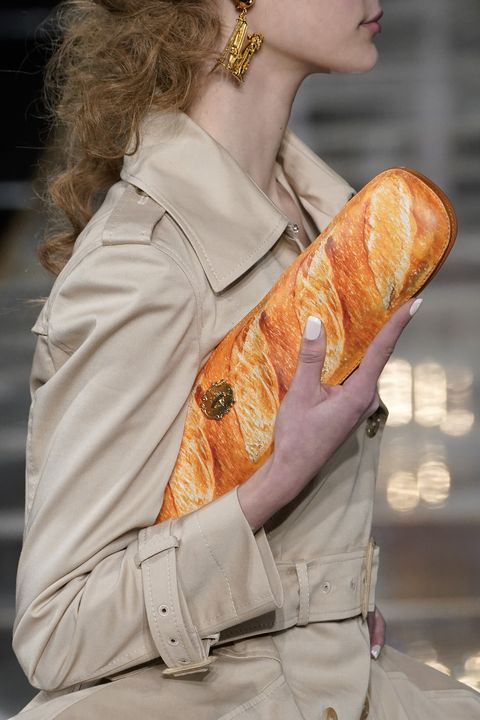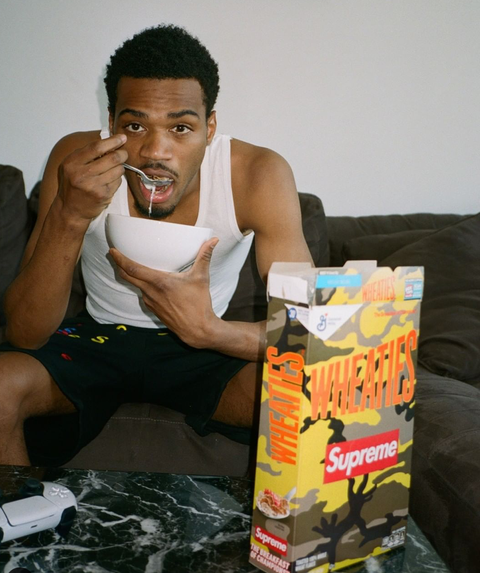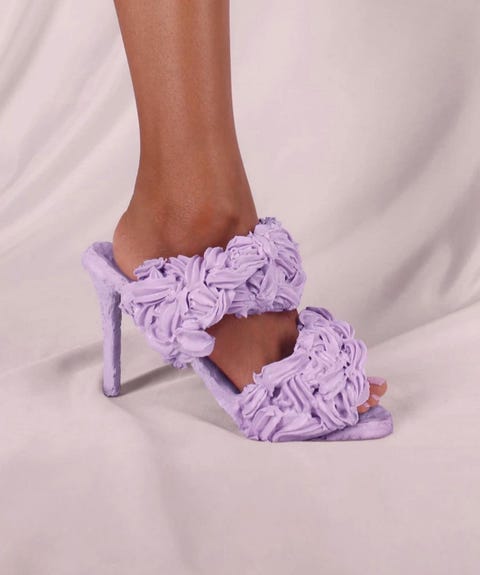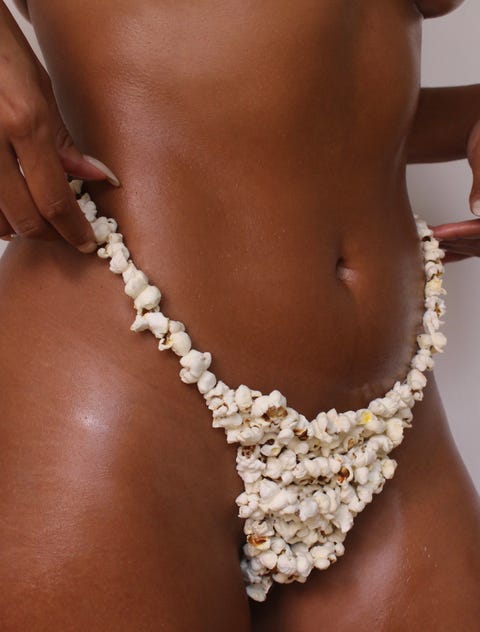In the era of social media, photogenic snapshots of the industry's latest items and trends are inevitable, so much so that it might seem boring now. Yet there's a handful of creators spinning that concept on its aesthetic head, bringing craft back to fashion in an appetizing way and pioneering what it means to be a food lover in the fashion world.

If not for fashion week, luxury brands like Burberry, Maison Kitsuné, Chanel, Louis Vuitton, and Dior alongside streetwear collective Kith have taken the experiential route with cafés, restaurants, or, in the case of Prada, century old bakeries, incorporating their stylish savvy into dining interiors and delightful menus.
In a more accessible approach cult-brands like Telfar and Supreme have collaborated with White Castle and Wheaties respectively while heritage house Maison Margiela, in collaboration with Tommy Cash, designed "baguette slippers" and branded ramen that allowed fans to gobble up couture in a new way. CR is also not one to stray away from food's power, accessorizing Cartier jewels with petite sized flight meals that encapsulated tasty, luxurious setting for post-pandemic life for the latest issue AirCR.

Yet, there's something different about foodwear. Its tantalizing and bizarre surrealism collides with a comfortable familiarity and you can't help but become addicted. Whether it's a Shin Ramyun cowboy boot or a bulky croissant headband, it makes us wonder: Is foodwear the latest fashion fusion?
Tyler Mitchell, a New York City-based artist, thinks that it is. Her ability to sculpt a vision into the edible have reserved her multiple pages in Bottega Veneta's first online zine Issue. Although she's no alien to working with food, her sculptures for the Italian house took on a more playful mood, which is a key word she keeps in mind when she crafts.
In the hands of Mitchell, Bottega Veneta purses are molded into dreamy yet eerily translucent gelatine pastel accessories and a bright lemon stomping boot; the house's famed heeled sandals are twisted, carved, and piped into footwear made of candy, banana leaves, and icing; and blinged out, heart shaped candies etched with intricate lining lay out like jewels. Each piece is an invitation to the Bottega Veneta dinner table.
"The process...was incredibly natural, yet pushed me to new limits. Testing out new techniques and ingredients really gave me insight on just how versatile making art with food can be, and how much patience it takes to get the look you’re going for especially while doing it for someone else," Mitchell said of her feature.

Her passion for food stems from an "everlasting love that [she's] had for cooking and food in general since [she] was young". Rather than posting typical foodie content to social media (that is, generic photos of plated meals), she wanted to showcase food's vitality creatively. It's that very ambition and mindset that allows her to find inspiration everywhere. "You know when you see something that you admire, say a nice handbag, and think of how many ways you want to style it?," she explained. "Instead, my mind goes to 'wow, how can I recreate this out of food?' It's just the way I’m wired." Her wondrous way of reinvention can certainly birth anything into something, even a bowl of unfinished popcorn kernels, which Mitchell said she turned into a pair of popcorn panties or "buttery, wearable goodness".

Gab Bois, a Montreal-based artist that specializes in food shaped fashion, also attributes her proclivity towards the niche to her upbringing. "As a child, I would organize the food on my plate to create different scenarios and characters, making the whole eating experience a lot more enjoyable," she said. "It's actually how my parents got me to eat the food I didn't like, which is why I never saw playing with my food as a bad thing."
This path has shaped her work today, which would reveal collaborations with luxury brands including SSENSE and Coach. But the guest of the hour is her Instagram (@gabbois) which has rallied 541K followers ready to devour her quirky, hallucinatory art. Scrolling through her carefully curated feed, one would notice her knack for reimagining accessories and undergarments (alongside the clever, witty monikers she assigns to her projects). There's her "breakfast bras" (a collection of bras made from childhood cereals), the al dente brasagna, (a top layered with strips of lasagna pasta), and the "peppero-knickers"(a greasy, pizza rendition of underwear). Her accessories take on a "classier" appeal because of its elegant subtly, such as her produce and pastry handbags and headwear and shrimp hoops. Nevertheless, whatever piece she creates, her art takes on a strangely realistic structure, design, and silhouette, which accounts not only for her capabilities but also her gravitation towards fashion – "I love food references in fashion, like that 1957 Balenciaga cabbage hat, for example, or the Chanel grocery store fashion show of Fall 2014, and countless Moschino pieces," she said.
"I used to be very inspired by the Kenzo work when I started doing photography. It's always so strange and cool," said Vanessa McKeown, an artist who also refers to fashion when getting inspiration. "I'm really into looking at things from the 80's at the moment." The latter is definitely spotted on her Instagram (@vanessamckeown) which is a profile compacted with eccentric pops of color and spunky yet nostalgic I Spy like imagery. While her pieces are more conceptual and less physically modeled, McKeown believes that "food isn't ever going to out of fashion."
While these artists seem to blur the line between art and reality like magic, their work isn't to be mistaken for a quick brandish of a kitchen utensil. Projects can take up to minutes or hours, even days, depending on the material, the fashion item being replicated, and the type of production.
Mitchell typically takes one to two days, preferring a fast pace so that her ingredients don't go to waste. Some of this time is allotted to trial and error, a process reflected in her Bottega Veneta candy shoes. "I initially used store bought candies to melt down and sculpt the red candy shoe — which is the same technique that I went for when I made another shoe in the past, but it just wasn’t it," she remembered. "I quickly taught myself how to make homemade hard candy... and it came out perfectly."
Bois prefers to work quickly too (her production usually takes a couple of hours) especially when it comes to "leafy ingredients". Yet she's been able to maneuver around expiration dates with techniques that sustain her materials's usage like spraying cold water to solve color absence or positioning ingredients so that the faults are hidden from view.
If luxury's craving and social media's hunger for food content wasn't already notable, 2020 sure made it evident as TikTok became the official forecaster for all things "cool". Alongside style and beauty trends, food became an escapist cure for quarantine woes; people spent minutes whipping up cafe style Dalgona coffees, hours baking bread to mimic the serenity of cottagecore living, and manipulating food into tiny forms for cereal. With minimal accessibility to the outside world, filling the void with kitchen pastimes seemed to be a reliable option. "I feel like a lot of people got onboard during the initial quarantine phase when we were seriously trapped inside of the house and food seemed to be omnipresent – from that creativity started to really spike," noticed Mitchell. Bois also saw this natural peak in kitchen curiosities that occurred not only out of boredom but because of food's relatability and its cathartic association with "emotions, good or bad...".
As much as this foodie fascination is embedded in personal pasts and indicative of the present moment, it also foreshadows the sustainable future fashion can become. Much like the beauty industry's effort to naturalize the space with botanical products, a shift towards nature's goods in fashion also has potential, especially when it comes to material sourcing. "There are already some amazing overlaps like vegan leather made from pineapple, apple, and mycelium (more commonly mushroom leather). I can only see these practices becoming more mainstream with time..." said Bois. Brands like Stella McCartney and Hermès have already hopped on the mushroom trend she's referencing.
"How cool would it be for brands to turn say, a pineapple’s skin, into fabric and start making sustainable clothing from various food derivates?" explained Mitchell. Because a chunk of her work is centered on sustainability and social responsibility as much as it is innovation she believes there are ways that "we as a society can utilize materials that often go to waste and rework in an effort to be resourceful and help save the environment at the same time".
Fashion and food might have more in common than what meets the eye. Yet the movement's kaleidoscopic dimension forces us to take a look at the typical in a new light. "It's incredible to see how something we utilize on a daily basis can be transformed into literal works of art" remarked Mitchell. She's right about that – we may be what we eat, but who says we can't wear it too?

No comments:
Post a Comment